Bold, cheerful, summery, and even delicious, sunflowers are a plant that just about everyone recognizes and seems to love.
Not to worry, we’ve got everything you need to know about who might visit your sunnies for a nibble, including what they look like, and how you can deal with them.
We link to vendors to help you find relevant products. If you buy from one of our links, we may earn a commission.
Sunflowers are one of the most iconic and cheery flowers. With their bright yellow petals and tall stalks they can instantly brighten up any garden or yard. However coming outside to find ragged holes chewed into your sunflower leaves can quickly put a damper on your gardening enthusiasm.
If you’ve noticed damage to your sunflowers’ foliage you’re likely wondering, “What’s eating my sunflower leaves?” The culprits could be any of several very hungry pests that love feasting on these plants. Identifying exactly which one is attacking your sunflowers allows you to take steps to control them and protect your plants.
Common Sunflower Leaf Chewing Pests
Sunflower Beetles – The sunflower beetle is a foliage-feeding pest exclusive to sunflowers and more common in northern growing regions. Sunflower beetles defoliate crops, which can lead to significant yield loss if young plants are attacked. They chew irregular holes between the veins of leaves, leaving behind a skeletonized texture.
Cutworms – Cutworm caterpillars feed at night, hiding in soil around plants during daytime. They chew through sunflower stems at ground level as well as notching leaves. This can kill seedlings or cause wilting. Their damage often appears suddenly.
Grasshoppers – Both nymphs and adults of these jumping insects feed on sunflower foliage. They leave behind ragged, irregular holes of varying sizes depending on species. Severe attacks can significantly defoliate plants.
Caterpillars – Several moth and butterfly larvae species feed on sunflower leaves. Corn earworms, sunflower moth caterpillars, and painted lady larvae leave behind large, irregularly shaped holes.
Japanese Beetles – These flashy metallic green beetles with copper wings skeletonize leaves between veins. They feed in groups, so damage appears more extensive.
Slugs/Snails – Nocturnal slugs and snails use their raspy mouths to scrape away at leaf tissue, leaving holes with smooth edges. Their slime trails are evidence of their night feeding.
Earwigs – These odd-looking insects chew ragged, irregular holes in foliage at night. Look for them hiding in leaf axils during daylight hours.
Sawfly Larvae – The caterpillar-like larvae of these flies eat leaves from the edge inward, resulting in a notched, scalloped appearance. They often feed in groups which can quickly defoliate plants.
How to Find the Culprits of Sunflower Leaf Damage
To identify which pest is feeding on your sunflowers, you need to catch them in the act. Here are tips for finding the culprits:
-
Inspect plants closely first thing in the morning or at night with a flashlight to spot nocturnal feeders.
-
Check both sides of leaves as some pests feed from the underside.
-
Shake foliage over a light sheet of paper to dislodge insects for a better look.
-
Search for clues like slime trails, chewed leaf edges, fecal pellets, or nests which point to certain pests.
-
Capture a sample insect in a sealed jar for identification or consult an extension office.
-
Compare against images online to ID the pest.
Effective Ways to Control Sunflower Leaf Chewing Pests
Once you’ve identified which culprit is munching your sunflowers, you can take steps to stop further damage:
Manual Removal – Handpick larger insects like beetles, earwigs, or caterpillars and drop them into soapy water. Be persistent as they can quickly reinfest.
Row Covers – Install these lightweight fabrics over plants to create a physical barrier against pests. Secure the edges well.
Pesticides – Apply Bacillus thuringiensis (BT) insecticides which specifically target leaf-eating larvae and caterpillars.
Natural Predators – Attract beneficial insects like ladybugs, lacewings, and parasitic wasps which prey on pests. Avoid broad-spectrum pesticides that may kill them.
Companion Planting – Interplanting aromatic herbs like basil, thyme, or chamomile can help repel some pests.
Crop Rotation – Rotating annual crops in different beds each season denies pests their preferred food source.
Sanitation – Remove and destroy heavily damaged plants and prune out infested leaves to eliminate pests before they spread.
Resistant Varieties – Choose sunflower hybrids bred to be naturally resistant to common pests like beetles or downy mildew.
Repellents – Frequently spraying lightweight horticultural oils or insecticidal soaps on plants deters feeding and disrupts insect reproduction.
Preventing Future Sunflower Pest Problems
Implementing preventive measures is vital for avoiding severe leaf damage in the future:
-
Maintain healthy soil with compost to reduce plant stress and susceptibility.
-
Allow adequate spacing between plants to improve air circulation.
-
Water carefully at the base of plants to keep foliage dry.
-
Apply mulch around plants to suppress weeds, retain moisture, and hide pests.
-
Routinely inspect plants and take quick action at the first signs of damage before pests multiply.
-
Remove spent plants and debris after harvest to eliminate overwintering sites for pests.
With persistence using multiple control methods, you can conquer those leaf-munching pests on your prized sunflowers. Stay vigilant and take action at the first signs of chewed foliage to protect your plants and enjoy their unhindered beauty.
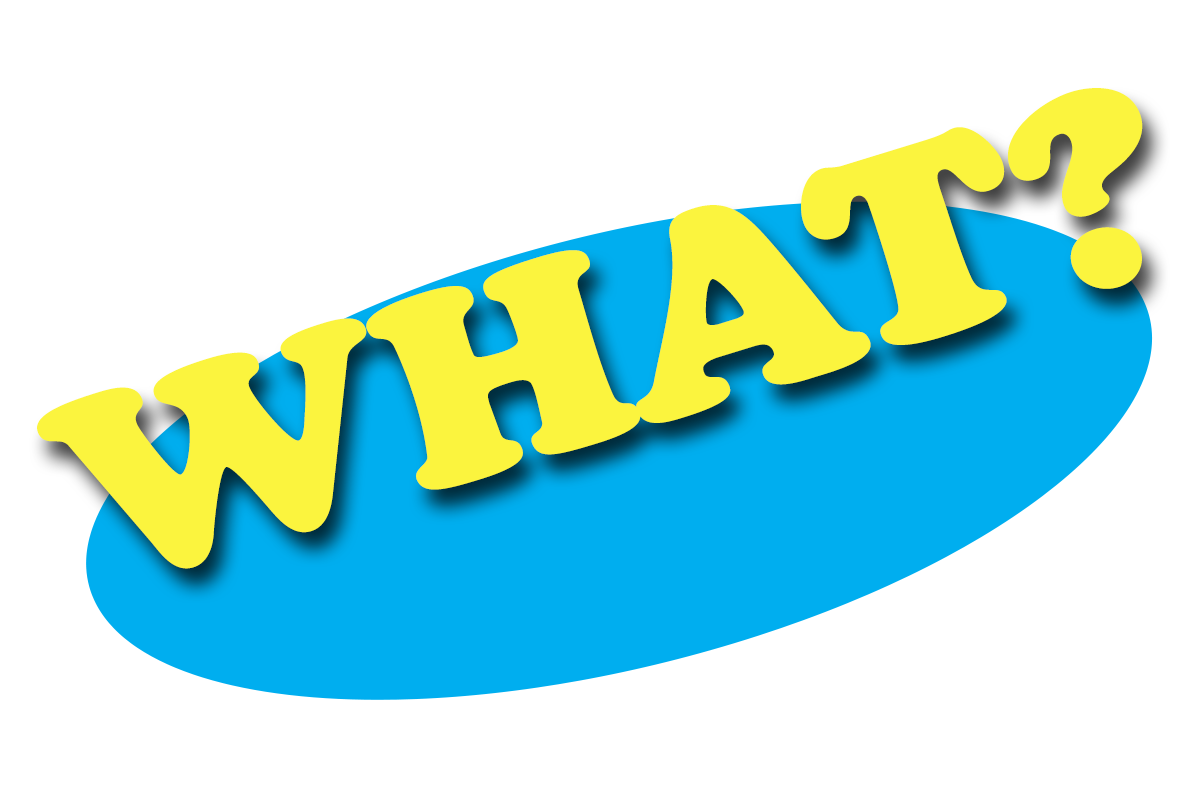
Wireworms and Darkling Beetles
Species from the wireworm family Elateridae, as well as false wireworms from the family Tenebrionidae, all love a sunflower snack.
Adult wireworms are known as click beetles and they come in various colors. Wireworm larvae have a good sense of smell, and move towards the carbon dioxide scent emitted by germinating seeds. They are white to brown, very slender, and have hard, jointed bodies.
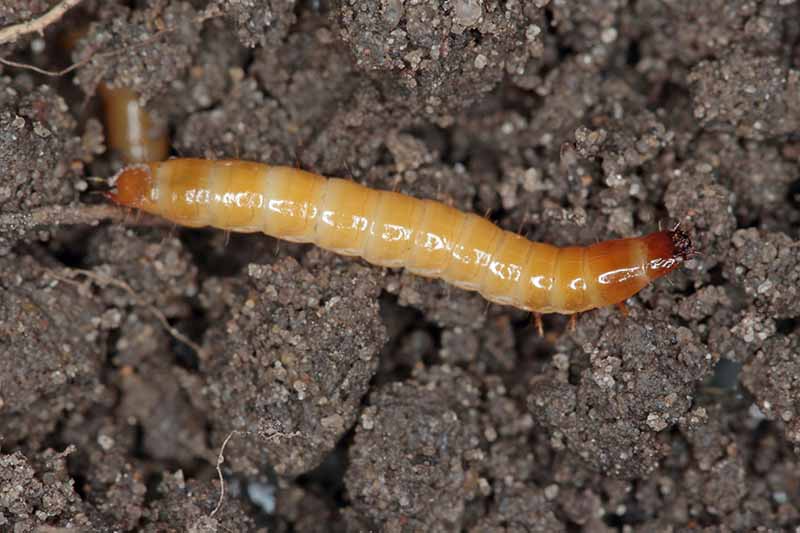
The larvae feed on the underground portions of the plants, including seeds and roots. As a result, the plant will turn yellow and wilt.
False wireworms, or darkling beetles, may also be seen in various colors. Their hard-bodied larvae look very similar to wireworms and come in shiny shades of cream, yellow, or tan. They feed on germinating seeds as well, so it can be hard to tell the difference between the two.
For both types of pests, prevent infestations by removing all plant debris from the garden, and tilling to expose the worms to predators. Let your chickens run loose after tilling, or handpick them yourself and put them in a bucket of soapy water.
If you see evidence of yellowing, it can be difficult to determine if wireworms are the problem. To trap the worms, try this trick:
Cut a potato in half and spear it on a stick. Bury the potato, leaving part of the stick uncovered so you can find it again. A week later, pull it out and see if there are any wireworms feeding on it.
Try applying beneficial nematodes such as Steinernema carpocapsae, available at Arbico Organics, to control wireworms.
Two other significant and common garden pests that don’t have six legs are birds and squirrels.
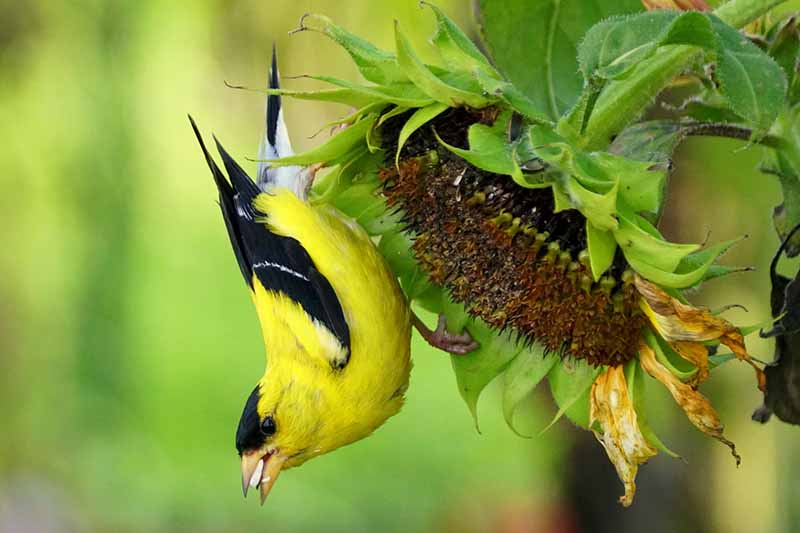
Blackbirds, goldfinches, grosbeaks, sparrows, doves, pigeons, and squirrels all love to snack on sunflowers. The high calorie, protein, and fat content of the seeds is attractive to animals that are breeding, storing fat for the winter, or preparing for migration.
Check out our article to learn how to protect sunflowers from birds and hungry squirrels.
How to Identify and Control Sunflower Pests
The list of pests that like to nibble on Helianthus can be a little daunting, but if we break this up into groups of which insects to watch out for during the different plant development stages, it becomes a lot simpler to understand and plan for.
Seedlings attract cutworms, wireworms, and sunflower beetles.
During the vegetative state, which is when the plant is growing those tall stems and big leaves, keep an eye out for sunflower beetles, thistle caterpillars, and stem weevils.
And finally, during flowering and seed development, watch for seed and head clipping weevils, maggots, sunflower midges, sunflower moths, and lygus bugs.
Of course, aphids can be a problem at any time.
Keep reading to learn more about each of these pests and how to control them.
Like many other plants, Helianthus attracts a variety of aphid types, including the melon, peach, and leaf curling plum aphid.
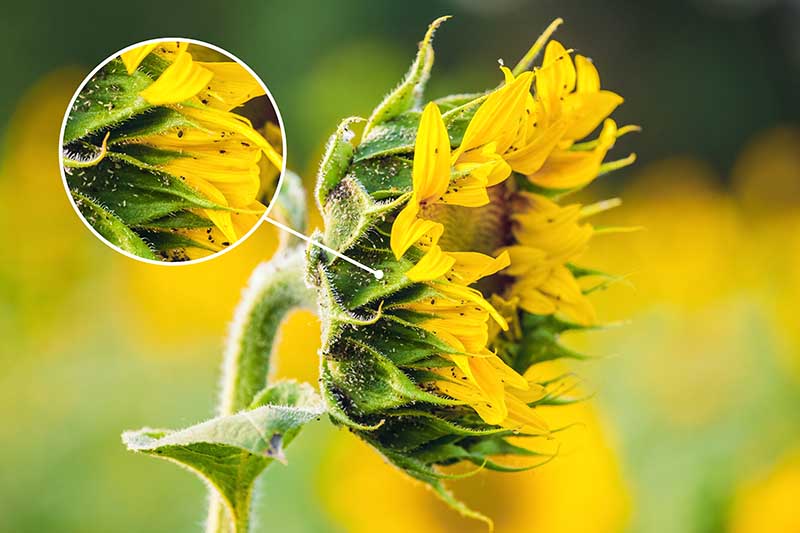
Regardless of the type, aphids are small insects that will suck on leaves, young stems, and flower petals. They also secrete honeydew, which ants and painted lady butterflies like to feed on, and which can develop sooty mold.
Insecticidal soaps, such as this one from Bonide that’s available at Arbico Organics, can be effective against aphids and are safe for pollinators if applied correctly.
There are several species of cutworms that find new sunflower seedlings delicious. In fact, it is recommended to farmers to plant a border of Helianthus around gardens or fields to attract the cutworms away from other crops.
Leaf damage looks like small transparent sections chewed by young larvae, notches, and wilting. But cutworms get their name from their habit of clipping the plant off at the soil line, a very incriminating symptom.
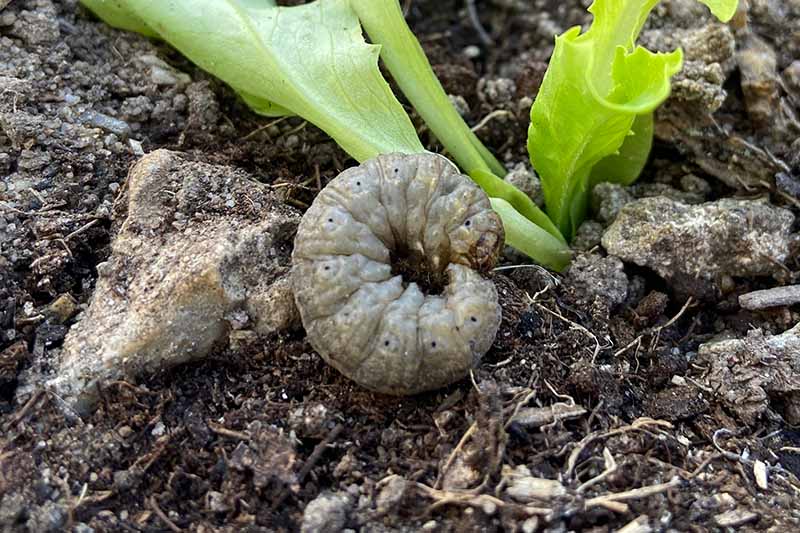
Most cutworms feed at night and hide in the soil a few centimeters from the plant. To find them, gently dig the soil around the plant and look for fat, soft, curled brown or gray larvae.
Preventative options include weed control, as weeds shelter and feed cutworms before your plants are up. In the fall, work up the soil to expose the larvae and pupae to hungry birds. Handpick the larvae at night after watering or a rainfall, or let your chickens do the work for you.
Cutworms love to live in the grass, so leave a three-foot-wide bare soil strip in between your lawn and garden. This makes it harder for the larvae to get to your plants.
Create a homemade barrier around each seedling at planting time. Cut the bottom out of a milk carton and push it two inches into the soil to surround the seedling.
You can also spread a layer of diatomaceous earth around the base of each seedling as a fatal barrier.
Try Perm-Guard Crawling Insect Control, available at Arbico Organics.
Beneficial nematodes, especially Steinernema carpocapsae, available at Arbico Organics, will attack the larvae in the ground and are safe for everyone involved, including the bees!
Alternatively, apply a Bacillus thuringiensis product such as Monterey Bt Liquid, available at Arbico Organics. This is another pollinator safe and effective option.
Lygus bugs (Lygus spp.) come in shades of green to red-brown and have a distinctive light-colored triangle at the wing base.
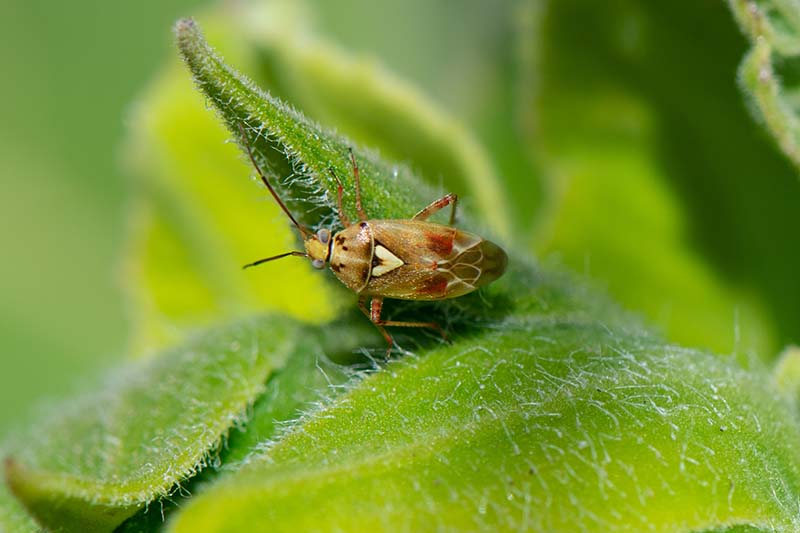
Nymphs are green and look like aphids, but are much faster moving and don’t have the aphid’s characteristic “tailpipes” (cornicles).
Lygus bugs feed by injecting enzymes that digest plant tissues into the plant and sucking the nutrients out. Feeding on seeds causes brown spots, also known as kernel brown spot, and a bitter taste. It can be a serious problem for farmers and for home gardeners if you plan to harvest seeds for snacks.
Lygus bugs can be hard to control because they move quickly so are hard to catch with a spray. If you choose to apply an insecticide in the case of a severe infestation, apply early in the morning when the bugs are less active. Use an insecticidal soap as you would for aphids.
Zygogramma exclamationis are easy to recognize. They are round beetles with a red-brown head and cream-colored wings covered in reddish-brown longitudinal stripes.
The larvae are almost cute, with fat pale green to yellow bowling-pin-shaped bodies. Adult feeding creates shotholes in the leaves, and larvae eat transparent windows into the leaves.
Unlike the pests discussed above, sunflower beetles are specific to Helianthus. They are the most damaging defoliator of sunflowers in North America.
Normally, beetle numbers are kept in check by beneficial insects in nature. Different types of ladybugs, such as the thirteen-spotted and convergent varieties, eat the eggs.
Lacewings eat the eggs and larvae, and damsel bugs, two-spotted stink bugs, and ground beetles also target the larvae.
Planting later in the season can help reduce defoliation. Insecticidal soaps can be effective, as well as neem products such as AzaSol, available at Arbico Organics.
Homoeosoma electellum can be a serious pest of cultivated sunflowers. The adult moths look like little light brown-gray cigars, and the larvae are brown with longitudinal white stripes.
The adults are mostly nocturnal, resting under the leaves during the day, and they lay eggs on the flower heads. Watch for dark frass (aka insect poop) and webbing on the flower heads, which indicates the larvae are feeding inside.
Young larvae feed on pollen while older larvae feed on the seeds and flower head tissues. Larvae feeding damage increases the risk of infection by Rhizopus fungi, which will rot the flower heads.
In the wild, over half of the larvae are parasitized by wasps. Large fields of big headed, cultivated Helianthus provide a huge amount of available refuge for the larvae, rendering the parasitoid wasps less effective. But small plantings like your garden should be well protected by these beneficial insects!
Some cultivars of sunflowers don’t produce pollen. This may deter pests that rely on pollen for food during one or more life stages. Read about some of the best pollenless cultivars in this guide.
Try a Bacillus thuringiensis product such as Monterey Bt Liquid to treat plants infested with these larvae. Insecticidal soap or neem-based products such as AzaSol are also options.
Contarinia schulzi are tiny midges that lay eggs in sunflower heads, and the larvae feed on the tissues of developing seeds and bracts. This causes low seed production and twisted, gnarled flower heads.
Damage is not usually widespread. Delaying planting by a couple weeks can help reduce the risk and severity of potential infestation.
Try rotating where you plant your sunflowers each year so you aren’t planting directly into an infested site. Some hybrids are resistant to midges, so keep an eye out for those if these insects have been a problem in the past.
Insecticides are not effective since the tiny midge larvae are very well protected inside the sunflower heads.
The larvae of the beautiful nectar-loving painted lady butterfly (Vanessa cardui), thistle caterpillars adore a good sunflower snack.
They come in a variety of colors from light green to black, with a light stripe down both sides, and branching spines all over their bodies.
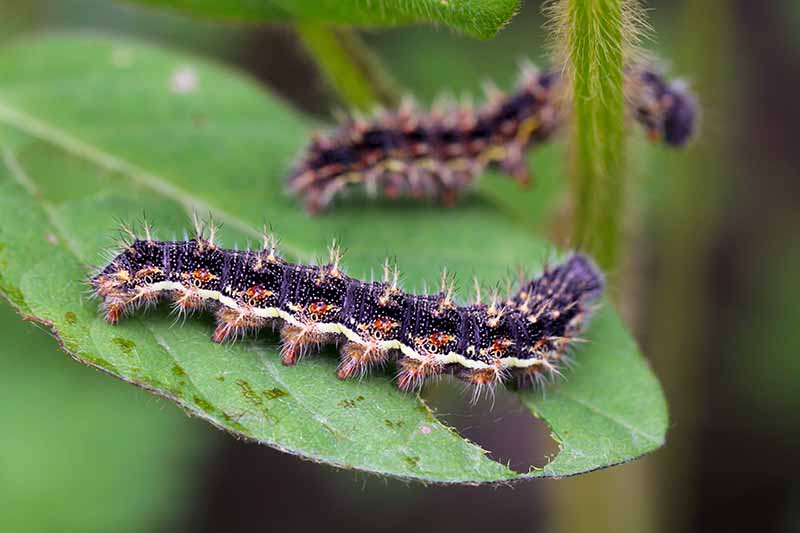
The larvae feed on the leaves, creating irregularly shaped holes, and surround themselves with webbing.
Damage is typically minimal and doesn’t warrant treatment, but it is good to know who is chewing on your precious plants. If these pests do become a problem, control them as you would sunflower moths.
There are several different weevils that feed on Helianthus, including the head clipping weevil (Haplorynchites aeneus) and the gray (Smicronyx sordidus) and red seed weevils (S. fulvus).
You’ll know a weevil when you see one. They have long snouts, like an elephant!
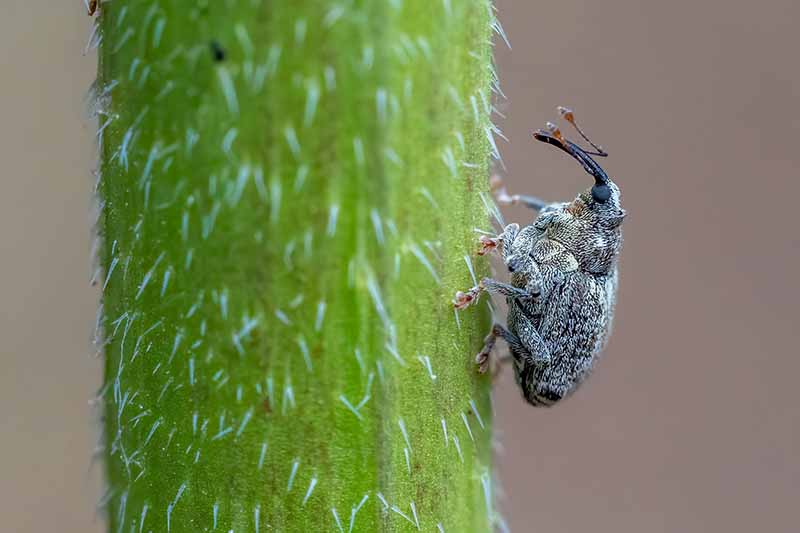
Weevils are pros at playing dead, though, so the adults can be hard to find. Shadows from birds flying over or you rustling through your flower patch can cause them to stiffen and drop off the plant as if they are dead.
The head clipping weevil causes damage you won’t be able to miss. They girdle the flower stem or leaf petioles, leaving partially severed heads and leaves hanging sadly on the plant.
The gray and red seed weevils, each the color of its name, are the most common damaging pests of Helianthus, with the red weevil being the more common of the two. The adults feed on pollen and lay eggs in developing seeds, which the larvae eat once hatched.
The same products that work against sunflower moths will work for weevils. Concentrate application of neem products or insecticidal soaps on the backs of the flower heads. The best time to control sunflower moths and weevils is often overlapping, so you can kill two bugs with one application if both pests are present!
Since weevil larvae drop into the soil to pupate, beneficial nematodes can be very effective in preventing future infestations.
Make sure the product you choose contains the nematode species Heterorhabditis bacteriophora.
NemaSeek Hb Beneficial Nematodes is a good option, and it’s available from Arbico Organics.
How to Protect Your Sunflowers From Pests in Southern Arizona
FAQ
How to get rid of birds eating sunflower leaves?
Control Methods
If the damage is excessive, hang reflective items such as sparkly streamers to scare them off. However, birds generally acclimate to scare tactics, so it helps to move the device every few days. Another option is bird netting stretched over the plants for protection.
What are chewing holes in my sunflower leaves?
Caterpillars are the larvae of moths and butterflies. A diverse group, these hole-making pests range from tiny inchworms to hornworms 4 inches long. Some types are nocturnal; others feed around the clock.
What is the best insect spray for sunflowers?
Insecticidal soap as well as dawn dish soap (1 1/2 tsp per quart) mixed with water and sprayed on the plant’s seed head can be used.
What eats sunflower leaves at night?
If something is eating your sunflower leaves during nighttime, then cutworms (the larvae of brown moths) are likely to blame. During the day, these pests hide in the soil, which is why you don’t find them when you go looking. Cutworms eat sunflower leaves and stems. Sprinkle diatomaceous earth (DE) all around the soil of your sunflowers.
What pests eat sunflower leaves?
One of the most common leaf-eating pests of sunflowers are cutworms, which hide in the soil durig the day and emerge at night to feed on the leaves. Other potential pests include beetles, grasshoppers, moths, aphids, caterpillars, slugs and snails, and leafcutter bees.
Why do sunflowers eat their tops?
If you’re noticing that the tops of your sunflowers are being eaten, there are a few possible culprits. One of the most common pests that feed on sunflowers is the sunflower beetle, which can chew away at the leaves and stems of the plant.
Do sunflower leaves eat worms?
However, these impressive plants are not immune to pests and other problems, such as leaf-eating insects. One of the most common pests that can damage sunflower leaves is the cutworm. These insects are active at night and hide in the soil during the day, making them difficult to spot.
What animals eat sunflower leaves?
Other than pests, various animals enjoy eating sunflower leaves. The animals that love to snack on your sunflower leaves are chipmunks, rabbits, voles, rats, squirrels, mice, deer, and birds like finches.
Do beetles eat sunflower leaves?
Various types of beetles like the Mexican bean beetle and Colorado beetle love eating the foliage of sunflowers. These pests prefer to eat young leaves, and if the sunflower plant is small, the leaf-eating beetles can have a major negative effect on the growth of the plant.
